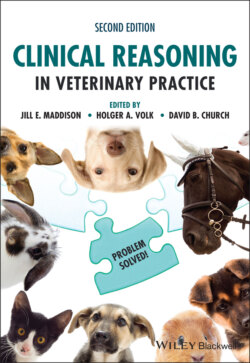Читать книгу Clinical Reasoning in Veterinary Practice - Группа авторов - Страница 23
I’ll do bloods!
ОглавлениеRoutine diagnostic tests such as haematology, biochemistry and urinalysis can be enormously useful in progressing the understanding of a patient’s clinical condition. However, relying on blood tests (often called a minimum database) to give us more information about the patient before we form any assessment of possible diagnoses can be useful for disorders of some body systems but totally unhelpful for others.
Serious, even life‐threatening, disorders of the gut, brain, nerves, muscles, pancreas (in cats) and heart, for example, rarely cause significant changes in haematological and biochemical parameters that are measured on routine tests performed in practice. Over‐reliance on blood tests to steer us in the right clinical direction can also be problematical when the results do not clearly confirm a diagnosis. The veterinarian can waste much time and the client’s money searching without much direction for clues as to what is wrong with the patient. And of course, the financial implications of non‐discriminatory blood testing can be considerable, and many clients are unable or unwilling to pay for comprehensive testing. Using blood testing to ‘screen’ for diagnoses can be misleading, as the sensitivity and specificity of any test are very much influenced by the precision of the test and the prevalence of a disorder in the population.
For experienced veterinarians, pattern recognition combined with ‘fishing expeditions’ (i.e. ‘I have no idea what’s going on so I’ll just do bloods and hopefully something will come up!’) can result in a successful diagnostic or therapeutic outcome in many medical cases in first‐opinion practice. However, there are always cases that do not yield their secrets so readily using these approaches, and it is these cases that frustrate veterinarians, prolong animal suffering, impair communication, damage the trust relationship with clients and on the whole make veterinary practice less pleasant than it should be.
You also have to know about and remember lots of diagnoses for this approach to be effective. This is problematical if the veterinarian does not recognise or remember potential diagnoses (e.g. for Brutus) or if, as discussed previously, the pattern of clinical signs doesn’t suggest many feasible differentials (e.g. for Erroll). It is also less useful for inexperienced veterinarians or veterinarians returning to practice after a career break or changing their area of practice.
It is for all of these reasons that we hope this book will enhance your problem‐solving skills as well as build your knowledge base about key pathophysiological principles. We want to assist you to develop a framework for a structured approach to clinical problems that is easy to remember, robust and can be applied in principle to a wide range of clinical problems. The formal term for this is problem‐based inductive clinical reasoning.
